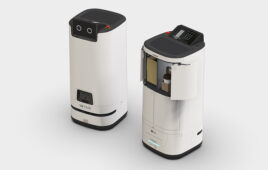|
Listen to this article
|
ETH Zurich students are developing a robot that can navigate low-gravity environments using a jumping-like mode of locomotion. The team recently tested the SpaceHopper robot in zero gravity scenarios on a European Space Agency parabolic flight.
The team hopes the SpaceHopper robot will be deployed on space missions and used to explore relatively small celestial bodies, like asteroids and moons. These bodies could contain valuable mineral resources that are rare on Earth. These bodies could also give us clues into our universe’s formation.
While they can provide great insights, these small celestial bodies are difficult to explore. One reason is because of their low gravity, contrasting to larger bodies like Earth. The researchers behind SpaceHopper designed it to show that legged robots are capable of this difficult task.
ETH launched the project 2.5 years ago as a focus project for Bachelor’s degree students. Now, it’s continuing it as a regular research project conducted by five Master’s degree students and one doctoral student.
About the SpaceHopper robot
SpaceHopper looks like a triangular prism with three legs sprouting from its corners. Each leg has three degrees of freedom. The team says this makes locomotion easier, as it lacks a preferred orientation. The lightweight robot has a unique way of getting around.
The SpaceHopper team breaks down the robot’s locomotion method into six movement capabilities that ensure reliable and fast travel on an asteroid. They are hopping to traverse large distances, attitude control during flight, controlled landing at a target point, precise short-distance locomotion, the ability to carry a scientific payload, and self-righting after landing.
In other words, the robot uses the power of all nine motors in its legs to take a stronger and precise takeoff. This allows the robot to cover large distances or hop over obstacles. While in the air, the robot uses its legs to reorient itself without any flywheels, allowing it to always land on its feet. When it does touch the ground, SpaceHopper’s feet give it a soft landing without any uncontrolled bouncing.
With the help of the European Space Agency’s (ESA) Petri Program, which offers practical experience and training to complement University work, the team is conducting a Parabolic Flight Testing Campaign. Parabolic flights, or “zero-gravity flights,” use special planes and roller-coaster-like maneuvers to create moments of weightlessness. In these moments, usually 20-30 seconds, the team can test SpaceHopper in space-like conditions.
So far, SpaceHopper has demonstrated the ability to reorient itself using only its legs, and has shown some jumping capabilities in this environment.






Tell Us What You Think!